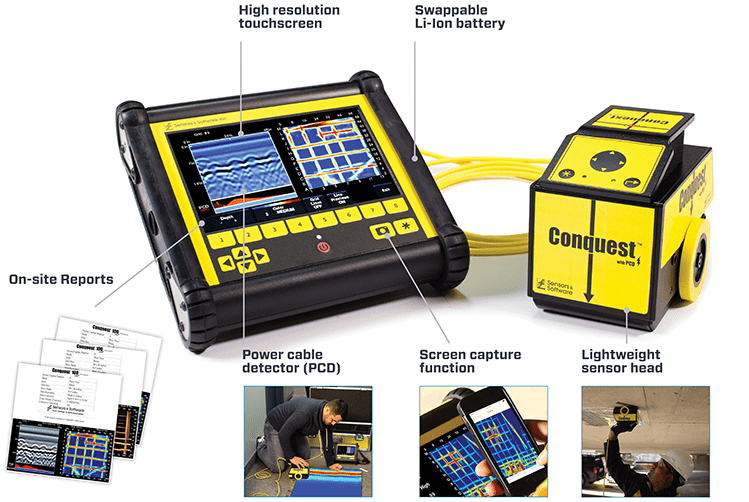RainierGPR Service Areas: Where We Offer Premier Concrete Scanning
Concrete Scanning: An Essential Action Towards Making Sure Structural Honesty and Safety And Security
In the realm of construction and infrastructure maintenance, the relevance of concrete scanning can not be overemphasized. This thorough process holds the key to introducing potential hazards hidden underneath the surface area of relatively strong frameworks. By employing sophisticated innovation and methods, concrete scanning acts as an essential tool in making certain that the integrity and security of buildings and bridges are upheld to the greatest criteria. Nonetheless, beyond its surface-level effects, the function of concrete scanning prolongs far much deeper than meets the eye.
Relevance of Concrete Scanning
Concrete scanning plays a vital role in making sure the architectural stability and safety and security of buildings and facilities jobs. By making use of sophisticated technologies such as ground-penetrating radar (GPR) and electromagnetic induction, specialists can non-destructively check concrete frameworks to spot possible defects, spaces, ingrained things, and reinforcement format. This process makes it possible for very early detection of anomalies that can compromise the stability of a framework, avoiding costly damages and guaranteeing the safety and security of occupants.
Concrete scanning is especially crucial during the planning and construction phases of a project. Before exploration, reducing, or coring right into concrete, scanning assists recognize the exact places of rebar, post-tension wires, and various other embedded components, decreasing the risk of unexpected hits that might lead to structural weak points. In addition, concrete scanning help in top quality control by confirming the density of concrete covers and detecting any type of discrepancies that may influence the general sturdiness of the structure. Ultimately, purchasing concrete scanning services is not only a proactive procedure to mitigate threats however likewise an essential step in the direction of keeping the long-term safety and security of structures and framework.
Technology for Concrete Assessment

Advantages of Early Detection
Prompt discovery of structural concerns can substantially mitigate risks and make sure the longevity of building tasks. By determining potential problems early on in the building and construction procedure, stakeholders can take proactive procedures to deal with concerns prior to they intensify into bigger and more pricey troubles. One of the essential benefits of early discovery is the avoidance of architectural failures, which can present serious security risks and bring about task delays and economic losses.
Moreover, very early discovery enables timely fixings and upkeep, which can aid prolong the lifespan of the structure. By addressing concerns promptly, building groups can avoid pricey fixings and even the demand for premature substitute of architectural elements. This proactive strategy not only saves time and money but additionally boosts the overall safety and durability of the building and construction job.
Furthermore, early discovery can boost job preparation and useful content decision-making by supplying stakeholders with valuable understandings into the condition of the framework. Equipped with this information, job supervisors can make educated selections regarding construction approaches, timelines, and materials, leading to a lot more efficient and effective job end results.
Guaranteeing Structural Security
Making sure the architectural stability of a construction job is paramount to its security and longevity. Structural stability describes the capability of a building or infrastructure to keep its type and function under environmental conditions and different lots. To attain this, complete evaluation and tracking of the framework are essential. Concrete scanning plays an important function in making sure architectural security by spotting potential concerns such as voids, delamination, or support corrosion that can jeopardize the stability of the structure with time.
By using innovative scanning modern technologies like ground-penetrating radar (GPR) and electro-magnetic induction, building and construction specialists can non-invasively examine concrete frameworks to identify locations of problem underneath the surface area. This proactive method permits the early discovery of defects or weaknesses, enabling punctual repairs or support to protect against structural failings.
Regular concrete scanning throughout various building and construction stages and throughout the life process of a framework can help preserve its security, alleviate threats, and make certain the security of owners. By prioritizing architectural stability via concrete scanning, building jobs can enhance their durability and durability, inevitably adding to higher security and longevity.

Avoiding Important Failures
Executing routine examinations, such as concrete scanning, can disclose concealed issues like gaps, fractures, or corrosion that might compromise the stability of a structure. By utilizing sophisticated scanning modern technologies like Ground Penetrating Radar (GPR) or Concrete X-ray, designers can non-destructively assess the problem of concrete and recognize weak factors that need reinforcement or repair work.

Conclusion
In conclusion, concrete scanning plays a vital duty in making sure architectural stability and safety and security by using innovative innovation for early discovery of possible concerns. This proactive method assists protect against critical failures and ensures the security of frameworks. It is vital to prioritize concrete examination as a conventional technique to shield the longevity and security of buildings and framework.
Concrete scanning Click This Link plays an important role in guaranteeing the architectural honesty and safety and security of structures and infrastructure tasks. Furthermore, concrete scanning help in top quality control by verifying the density of concrete covers and finding any kind of disparities that may influence the general resilience of the framework. Concrete scanning plays a critical duty in ensuring structural stability by identifying prospective concerns such as spaces, delamination, or reinforcement my website corrosion that might endanger the integrity of the framework over time.

In final thought, concrete scanning plays an essential function in ensuring architectural honesty and safety by utilizing sophisticated innovation for early discovery of potential concerns.